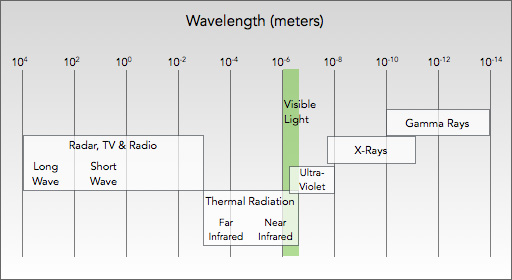Principles of Light
Basic Theory
Light is a form of radiant energy that travels in waves made up of vibrating electric and magnetic fields. These waves have both a frequency and a length, the values of which distinguish light from other forms of energy on the electromagnetic spectrum.
Visible light, as can be seen on the electromagnetic spectrum, represents a narrow band between ultraviolet light (UV) and infrared energy (heat). These light waves are capable of exciting the eye's retina, which results in a visual sensation called sight. Therefore, seeing requires a functioning eye and visible light.

Lighting Systems
Light can be produced by nature or by humans. "Artificial" light is typically produced by lighting systems that transform electrical energy into light. Nearly all lighting systems do so either by passing an electrical current through an element that heats until it glows, or through gases until they become excited and produce light energy.
Incandescent light sources are an example of the first method, called incandescence. Current is passed through a filament, which heats until it glows. Because this method is considered wasteful (most of the energy entering the lamp leaves it as heat instead of visible light, other light sources were pioneered that rely on the gaseous discharge method, including fluorescent, high-intensity discharge (HID) and low-pressure sodium light sources.
A typical lighting system is comprised of one or more of these light sources, called the lamps. Fluorescent, HID and low-pressure sodium lamps operate with a ballast, a device that starts the lamp and regulates its operation. Lamps and ballasts in turn are part of the luminaire, or light fixture, which houses the system and includes other components that distribute the light in a controlled pattern.
Designing the Lighting System
To produce a new lighting system in a construction or renovation scenario, it must be designed. The designer must determine desired light levels for tasks that are to be performed in a given space, then determine the light output that will be required to meet those objectives consistently, taking into account all the factors that degrade both light output and light levels over time. Equipment must then be chosen and placed in a layout to produce the desired light distribution. The designer must also consider a range of quality factors in his or her design choices and equipment selection, including color, minimizing glare, safety and if required, aesthetics.
Managing the Lighting System
To properly manage an existing system, many types of professionals may be involved, from electrical contractors to facilities manager - - for our purposes in this case, we will call them lighting managers. The lighting manager must ensure that the existing lighting system consistently provides the most effective lighting at the lowest operating and maintenance cost. This may entail retrofitting or upgrading the system to reduce energy costs and/or increase performance, a planned maintenance program to keep the system operating at peak performance, and other activities that will ensure that the lighting system is continuously doing its job.
By Gary Turpen, inter.Light, inc.
Additional References:
Lighting Principles and Terms - U.S Department of Energy

